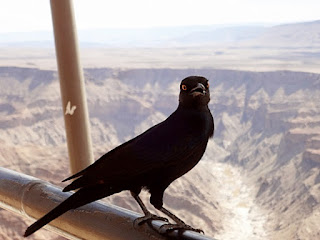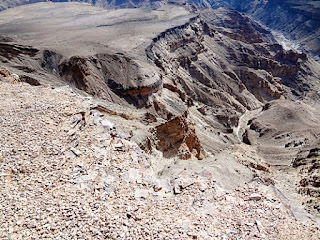We had to head 125 km east to skirt around the Restricted Area 1 of the diamond company. We went as far as Aus and turned south. As we neared Aus, we encountered the wild horses of the Namib desert at Garub. We saw a couple dozen of them, but most looked scrawny and in poor condition. Nobody knows for sure where the horses came from, but the herd ranges from 80-250 and stays mostly in this same area.
A desert horse of the Namib, near Aus.
We saw lots of ostriches along the way, but always in very small groups or singly. The black ones are males. Females are more grey.
A cool rock outcrop in the middle of the desert.
The layers of different rocks make it look like snow on the peaks of the mountains when it is only layers of black and white on their sides, eroding at different rates.
We stopped at a dry riverbed for a stretch. The cracked mud looked pretty interesting and I wandered a little ways looking at the different sizes of the cracked chunks.
Truly a desert shot where water doesn't last long.
Jason eating puffy tomato ball snacks and Brian being a clown, waiting for us to finish looking at the dried up mud. They both thought we were crazy for the things we wanted photos of.Interesting waves of rock.
We missed the turnoff to the canyon and stumbled onto these green fields being irrigated by the Fish River water.
Vineyards, miles of them, are being cared for by the workers that live in these straw huts around the edges of the fields. Namibia may soon turn out wines from these grapes.
Some have tin walls or roofs and some are just flattened oil drums as walls. They must be extremely hot in this desert heat. Some were square or rectangular with flat roofs, while in the distance, others have the round peaked roofs of a traditional African rondavel.
Could you live in this hut?
Someone has a sense of humor and business here. The sign says "Fabulous Bar" on the hot, tin building with no windows. Hope you like your beer warm.
We finally reached the Fish River Canyon viewing area in the park in late afternoon. We blew a tire and lost a hubcap getting here. The pavilion had signs that told us about the history, origin, etc. of the area and the canyon.
Hell's Bend in the canyon below the viewing point.
The Fish River Canyon is the largest in Africa and the second largest in the world after the Grand Canyon.
We were late in the day so much of the rocks are in shadow, but it was a spectacular site.
The hard cap of rock keeps the rock below it from eroding at the same rate and creates different levels, making the canyon visually interesting.
This bird didn't want the oatmeal someone had left, but didn't mind us getting close to it.
Jason checking out the canyon with our binoculars.
Jason and Karen at the Fish River Canyon. It was a hot afternoon.
A canyon view from the viewing area. In total it's about 160 km long, up to 27 km wide, and in places almost 550 m deep. The Fish River is the longest interior river in Namibia.
The pavilion area with its shade over the rest benches. We were the only people there and saw only one other vehicle in the park. It's a very long drive from Luderitz to get here. We left at 8 am and got here about 1-2 pm.
Looking down into the canyon. There were no fences anywhere. Just the railings at the viewing pavilion.
We drove a ways up another rocky road to get a different view.Looking back towards the pavilion. We could step right up to the edge, but seeing the crumbly rock, we were reluctant to do so.
It really is a grand canyon of Africa.
Our spare tire on the rental. We blew out a tire on the rocky road getting out to the canyon. We had our eyes peeled for the hubcap, but found only other broken caps and one belonging to a Toyota.
Another view with different coloring in the rocks with the different light. At the lower end of the river is a hot springs resort at the town of Ai-Ais.
The river in the bottom of the canyon has a tiny bit of water in it.
Another view of the Fish River Canyon.
Looking the other way, we see a whole different view.
The soft, fuzzy, white weeds just looked luminescent in the light of the afternoon as we sped by.
Our first full view of the Seeheim Hotel, our accommodation for the night. It's hidden in a tiny canyon that can't be seen from the road. We turned off the major road onto the dirt road but couldn't see any buildings until after we followed the sign into the drive for the place, It's the only place around for miles. The train comes by a couple of times a week here. Our room was way up at the top right corner of the place. Lots of steps.
Along the steps to our room, someone got very clever.
The other side of the stone stairs.
A quiver tree. Named not because they shake, but the branches were hollowed out and used to carry the arrows of bow hunters in the desert.
The pool at the hotel. The water sounded inviting after a long, hot drive, but it didn't look clean enough to want to get in. The owner assured us we could wear our clothes in and they'd be dry within an hour in the desert air. We all washed our clothes in the room and they were dry to wear the next morning, even though we had rain here overnight.
An Amazon Grey parrot at the hotel. He spoke only Afrikaans.
A stuffed baboon in the lobby. Fierce looking.
An oryx in a pen outside.
The Seeheim Hotel, a quirky place with lots of levels, all made of stone.
Jason on a zebra hide enjoying a cold beer on arrival.
Karen and Jason enjoying a Taffel beer at Seeheim.
This dog would chase that dumbbell for hours if you'd throw it for her.
Enjoying our beers on the patio. We had difficulties getting cell phone reception here and had to go incommuicado.
The hotel kept a bronze turkey and several white ones. Myra once raised turkeys in Ireland and told us the bronze ones were hard to find now.
Having breakfast at Seeheim. Kudu sausages and eggs, with toast, fruit, yogurt and cereal available, too. Our dinner the previous night was kudu steaks, chips and salad. Quite tender and tasty.
We had to backtrack from Seeheim to Keetmanshoop, about 45 km east to get fuel, a new tire and hubcap. While the men had the new tire put on, Myra and I walked down to this old church that is now a museum. We didn't have time to go in, but liked the stone structure with old farm machines outside.
Th other end of the museum with its steeple/tower.
Women all over Africa carry stuff on their heads. This one in her floppy had was no different, but surprised us in this crossroads town. Keetmanshoop has more petrol stations per capita than anywhere else, but two of the fuel stations we passed had no gasoline. Go figure!
One VW hubcap cost more than the rental car for a day, so we found a box of four generic ones in the shop there. This basket man came along as we were waiting for Brian to buy the hubcaps. He had dog and pig beds and many different shapes and sizes, all woven by him. When we don't buy, he still asks for some money for food. That seems to be a common ploy. No buy then beg.
He did good work on the baskets. We filled up with gas and headed off to make tracks towards the dunes of Sossusvlei.

























































No comments:
Post a Comment